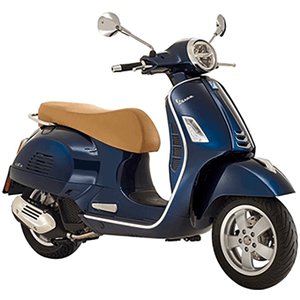Vespa GTS 125 Super iGET (2017-2022) Review: A Timeless Urban Companion
Introduction
When it comes to blending Italian elegance with urban practicality, few names resonate as deeply as Vespa. The GTS 125 Super iGET (2017–2022) is a scooter that embodies this legacy, offering a harmonious mix of style, efficiency, and rideability. Designed for city dwellers who refuse to compromise on aesthetics, this model generation retains Vespa’s iconic curves while integrating modern engineering. Having spent a week weaving through traffic and cruising along coastal roads, I’m here to share why this scooter remains a compelling choice—and how it holds up against its rivals.
Design & Build Quality: La Dolce Vita on Two Wheels
The Vespa GTS 125 Super iGET is instantly recognizable, thanks to its monocoque steel body—a design staple since the 1940s. The 2017–2022 iteration refines this classic with subtle updates: sleeker LED lighting, a chrome-accented front fender, and a choice of retro-modern color schemes (think matte metallics and glossy pastels). The 790 mm seat height is accessible for riders of most statures, though the wide saddle might require tip-toeing for shorter individuals.
Practicality shines through details like the under-seat storage (fits a full-face helmet) and the optional rear rack for additional cargo. The 147 kg wet weight feels substantial at a standstill, but the low center of gravity makes maneuvering through tight streets effortless. Build quality is impeccable, with rust-resistant panels and a paint finish that shrugs off scratches.
Performance: Nimble, Efficient, and Surprisingly Zesty
Engine & Transmission
At its heart lies the 124cc single-cylinder iGET engine (9 kW/12 PS), Vespa’s answer to stricter emissions norms. The fuel-injected motor delivers smooth acceleration, peaking at 10.7 Nm of torque. While it won’t set speed records (top speed: ~95 km/h / 59 mph), the powerband is perfectly tuned for urban chaos. Throttle response is crisp, and the CVT transmission eliminates gear shifts—ideal for stop-and-go traffic.
Fuel efficiency is a highlight. During my test ride, I averaged 45 km/L (106 mpg), translating to a 315 km (196 mi) range from its 7-liter tank. The engine stays vibration-free even at its 1,750 rpm idle, though steep hills demand patience.
Handling & Ride Comfort
The GTS 125’s 12-inch wheels and hydraulic suspension soak up potholes better than smaller scooters. The front disc brake (220 mm) offers strong bite, though the rear drum lacks the same urgency. Lean into corners, and the chassis feels planted, aided by the grippy Michelin City Grip tires (a common factory fitment).
Longer rides reveal a plush saddle and ergonomic floorboard positioning. Wind protection is minimal, so consider an aftermarket windshield for highway jaunts.
Riding Experience: Where Form Meets Function
Riding the GTS 125 feels like piloting a stylish extension of yourself. The upright riding position offers a commanding view of traffic, while the mirrors stay vibration-free at speed. Start-stop systems (not fitted here) are hardly missed—the iGET engine fires up instantly, even in cold weather.
Storage is a strong suit. The under-seat compartment includes a USB port (post-2018 models), and the optional top case expands utility further. Night visibility is excellent, with LED headlights casting a wide beam.
Competition: How Does It Stack Up?
The 125cc scooter segment is fiercely competitive. Here’s how the Vespa holds its ground:
-
Honda SH125
Honda’s flagship scooter counters with larger 16-inch wheels (better stability) and ABS (optional). It’s pricier but excels in wet conditions. The Vespa trumps it in style and resale value. -
Yamaha NMAX 125
Yamaha packs in tech: Bluetooth connectivity, adjustable shocks, and a liquid-cooled engine. The NMAX feels sportier but lacks Vespa’s timeless design. -
Piaggio Beverly 125
Sharing the Vespa’s DNA, the Beverly offers a larger 12-inch rear wheel and more storage. However, its angular design appeals less to purists.
Verdict: The Vespa GTS 125 isn’t the fastest or cheapest, but its design pedigree and ride refinement make it a lifestyle choice.
Maintenance: Keeping Your Vespa in Prime Shape
Owning a GTS 125 is relatively hassle-free, but adherence to service intervals is key:
- Oil Changes: Use 0W-30 API SL oil (1.3L with filter). MOTOPARTS.store stocks synthetic blends for extended intervals.
- Valve Adjustments: Check every 6,000 km. Intake: 0.10 mm (cold), exhaust: 0.15 mm (cold).
- Coolant: Replace every 2 years (2.1L of ethylene glycol-based fluid).
- Brakes: Upgrade to sintered pads for sharper stopping.
Common Upgrades:
- Tires: Swap to Heidenau K66s for wet grip.
- Exhaust: Aftermarket options like LeoVince enhance the engine’s throaty note.
- Accessories: Add a rear carrier or heated grips for winter commuting.
Conclusion: A Scooter That Ages Like Fine Wine
The Vespa GTS 125 Super iGET isn’t just transportation—it’s an heirloom. While rivals tout tech gimmicks, this scooter charms with simplicity and sophistication. Whether you’re threading through Rome or grabbing coffee in Milan, it delivers a ride that’s as effortless as it is exhilarating.
For owners looking to personalize or maintain their GTS 125, MOTOPARTS.store offers a curated selection of OEM and premium aftermarket parts. From NGK spark plugs to vintage-inspired racks, we’ve got your Vespa covered.
Ciao for now, and ride safe!



















